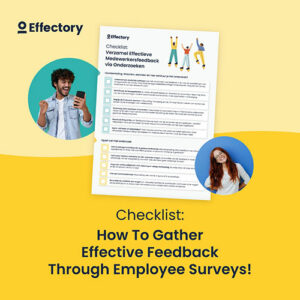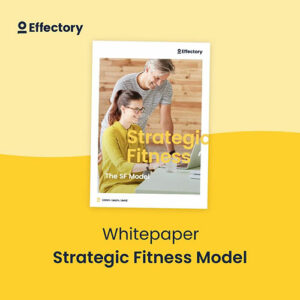The role of surveys in organizational change
In times of uncertainty, whether due to economic shifts, technological advances, digitalization, or other external crises, organizations need to adapt swiftly and efficiently, often having to do more with less. Involving employees in these changes isn’t just beneficial—it’s essential. Their insights help guide strategic decisions, optimize resource allocation, and smooth the transition process.
Mitigate risks to digitalization using employee feedback
However, restructuring can initially lead to a dip in productivity. Surprisingly, a significant number of organizational changes don’t fully achieve their intended goals. Studies suggest that about 60% of projects fail to meet objectives, resulting in financial losses, missed opportunities, and lack of focus1.
How to gather feedback from your employees
The definitive checklist for creating your employee engagement survey.
Download
The ‘stabilagility’ paradox
To successfully navigate transitions, it’s essential to understand employees’ direct experiences during a change: Do they feel leadership provides a clear vision of where the organization is headed? Do they experience that the organization has good practices for change management? Addressing these questions sheds light on the organization’s agility from the employees’ perspective.
At the same time, paradoxically, organizations need to maintain stability. This can be achieved through good people management practices and support systems, which involves helping employees understand what the upcoming change means for them on a team and individual level. Managers are key in this process; they need to set clear expectations for their teams, foster ongoing feedback, and reward performance.
Moreover, it’s important to understand whether employees feel they have good systems to make their work efficient. For example, do they have all the tools they need to perform well? Keeping a close eye on the Employee Engagement metric is vital, as well as addressing any signs of disengagement early on, as engagement directly impacts productivity.
What is employee engagement? The ultimate guide to engagement
Continuous employee feedback is key to a successful restructuring. It helps mitigate these risks and enables a quicker return to peak productivity levels.
Structuring surveys for maximum impact
From our experience, organizations that conduct surveys before, during, and after organizational changes are typically the most effective in managing transitions. Let’s have a look at the optimal types of surveys and their sequencing in times of change.
1. Strategic Fitness Model
When working with customers who are undergoing significant changes, we advise starting with the Strategic Fitness Model, as it enables organizations to assess if they’re fit to achieve long-term success and strategic ambitions.
The Strategic Fitness Model Whitepaper
Learn to navigate change effectively with Effectory's Strategic Fitness Model. Download your free whitepaper now.
Download
The Strategic Fitness Model is a survey consisting of 22 targeted questions that evaluate an organization’s employee engagement and the overall performance environment. This model provides a snapshot of their strategic readiness, particularly important for organizations operating in a changing and dynamic environment where they are required to adapt at a high pace.
By using the Strategic Fitness Model, organizations gain vital insights into the effectiveness of their change management. It clarifies the extent of change, the clarity of communication, and whether employees are performing as expected. Additionally, it provides an analysis that pinpoints potential bottlenecks, offering a clear direction for intervention.
While this model is a great starting point for understanding your organization’s position in the face of change, many of our customers are building a targeted listening process around it to manage the extensive process of restructuring. Therefore, we recommend supplementing the Strategic Fitness Model with a few follow-up surveys.
Take the First Step Towards Strategic Fitness
Measure your organization’s strategic fitness to achieve objectives by utilizing employee feedback for targeted growth.
learn more
2. Follow-up Pulse Surveys
Once management teams agreed on the top priority to act upon, they automatically seek a tool to manage progress. This is what Pulse Surveys do. They are short and focused, delving deeper into specific areas highlighted by the Strategic Fitness Model – especially where potential bottlenecks or lower scores were noticed. The goal is to understand the differences that have emerged, allowing organizations to adjust their strategies based on this feedback. These pulses can cover the entire organization, establishing a continuous feedback loop that effectively guides the change management process.
Development push
For areas particularly impacted—typically the bottom 20% of scoring teams or units—a more focused ‘development push’ is advised. These targeted surveys help understand and address the specific challenges these groups are facing. It assesses how these teams are coping with change and what support they need to improve their performance during this transition period. This approach gives organizations detailed insights, helping them to make specific improvements.
Post-change improvement check
Continuing with the feedback cycle, we advise conducting targeted Pulse Surveys after the change has occurred, focusing on specific improvement areas. For example, employees might be asked, “Are you able to do your job well?“. If responses are negative or show lower satisfaction, a follow-up open-ended question is triggered: “What would you need to perform well in your job during these times of change?“. This helps gather nuanced feedback from specific teams, providing actionable insights not just on a quantitative level but also offering qualitative depth from open-ended questions.
By structuring surveys in this step-by-step and targeted way, organizations can better manage change, minimize disruptions, and ensure that everyone’s voice is heard. The results are a smoother transition, a more engaged workforce, and ultimately, a stronger, more adaptable organization.
Pulse survey
Do you want to gather actionable feedback on specific topics? Tap into employee insights to grow, change or improve your organization.
view solution
The impact of a well-managed change process
Organizations that we work with who effectively engage employees through structured surveys during restructuring report several benefits:
- Reduced downtime and faster return to full productivity;
- Quicker adaptation to new organizational structures;
- Higher employee satisfaction and reduced turnover rates.
Key takeaways and your next steps
Throughout this blog series, we’ve shown how employee listening can enhance learning and development programs, boost management effectiveness, and sustain productivity and employee engagement during times of change.
Consider how you could leverage surveys in your own organization. Where could listening to your people make a real difference? Remember, the only way to lasting, sustainable change happens when you listen to the voice of every employee.
3 smart ways to use employee feedback series:
Book a free demo. See our solutions in action.
Effectory is Europe's Leading provider of Employee Listening Solutions. Schedule a product demo and discover how to enhance your employees' engagement.
Demo request



